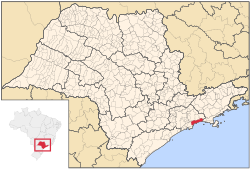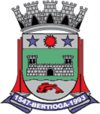Bertioga
| Município da Estância Balneária de Bertioga | |||
|---|---|---|---|
 |
|||
|
|||
 Location of Bertioga |
|||
| Coordinates: 23°51′17″S 46°08′20″W / 23.85472°S 46.13889°WCoordinates: 23°51′17″S 46°08′20″W / 23.85472°S 46.13889°W | |||
| Country |
|
||
| Region | Southeast | ||
| State | São Paulo | ||
| Metropolitan Region | Baixada Santista | ||
| Government | |||
| • Mayor | José Mauro Dedemo Orlandini | ||
| Area | |||
| • Total | 490.15 km2 (189.25 sq mi) | ||
| Elevation | 8 m (26 ft) | ||
| Population (2015) | |||
| • Total | 56,555 | ||
| • Density | 120/km2 (300/sq mi) | ||
| Time zone | BRT (UTC-3) | ||
| • Summer (DST) | BRST (UTC-2) | ||
| HDI (2010) | 0.730 high | ||
| Website | Bertioga City Hall | ||
Bertioga is a Brazilian municipality of the state of São Paulo in the Baixada Santista. It is part of the Metropolitan Region of Baixada Santista.
The population is 56,555 (2015 est.) in an area of 490.15 km². Because it neighbors resort towns, its population fluctuates greatly with the seasons. The more northern parts are dense forests and are virtually unpopulated. The municipality was created in 1995. Prior to that it was a part of Santos.
The municipality contains the 9,312 hectares (23,010 acres) Restinga de Bertioga State Park, created in 2010 to protect an area of mangroves, restinga and dense rainforest. Its limits are Mogi das Cruzes, Biritiba-Mirim and Salesópolis in the north, São Sebastião in the east, Atlantic Ocean to the south with Ilha de Santo Amaro (opposite to the city) and Santos in the west.
In 1979 Bertioga was the site of the death of Dr. Josef Mengele, a Nazi doctor at Auschwitz.
...
Wikipedia


